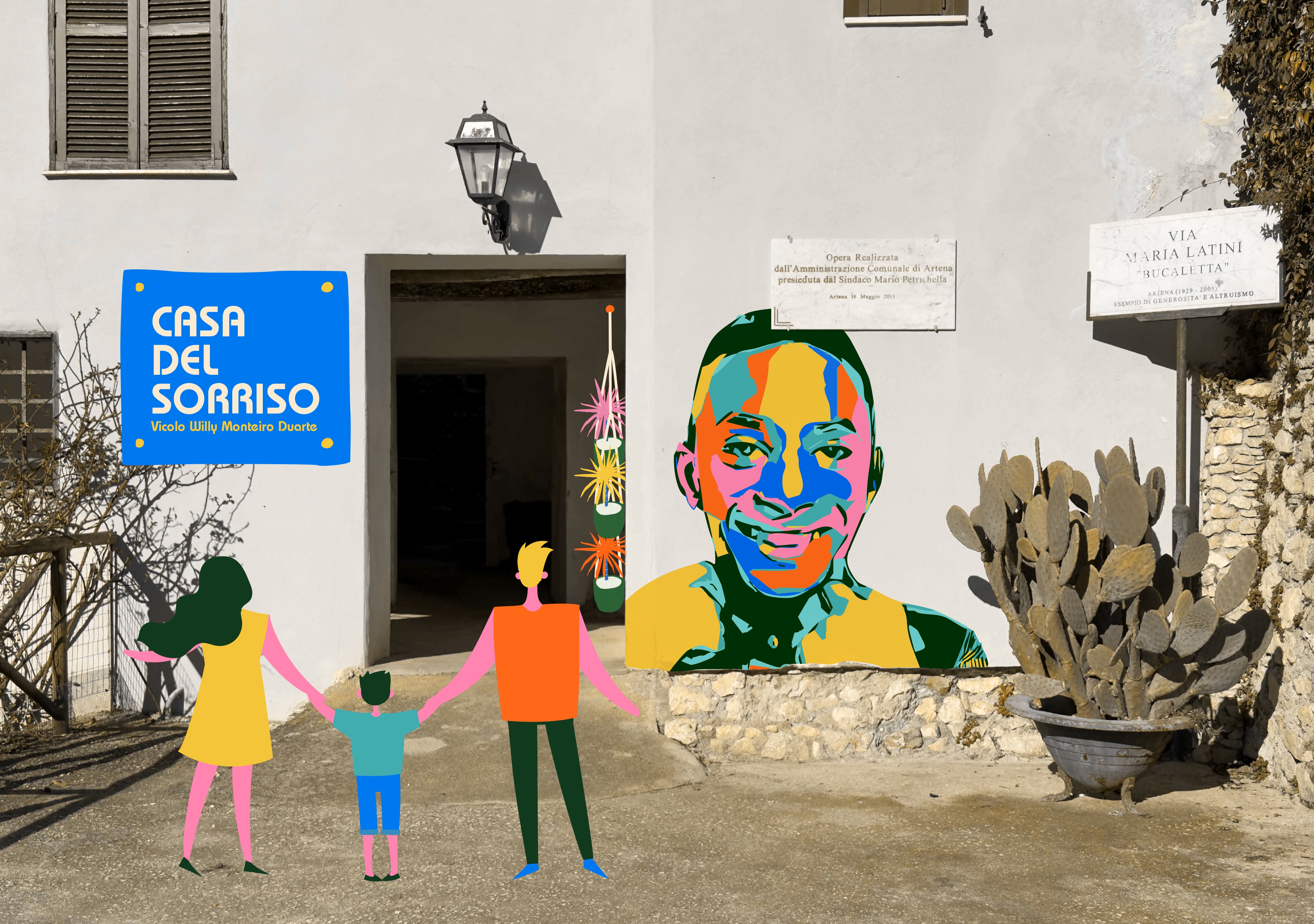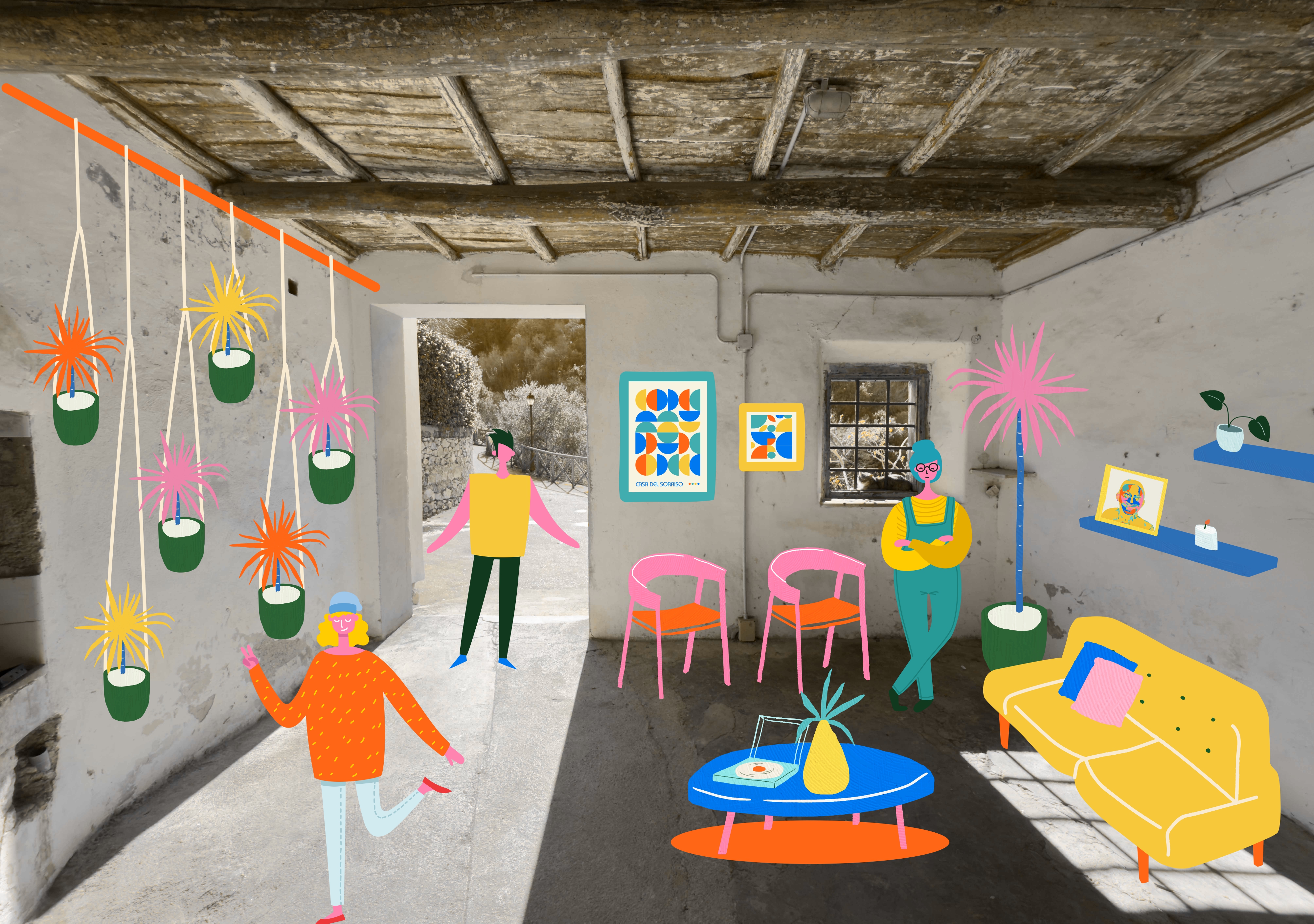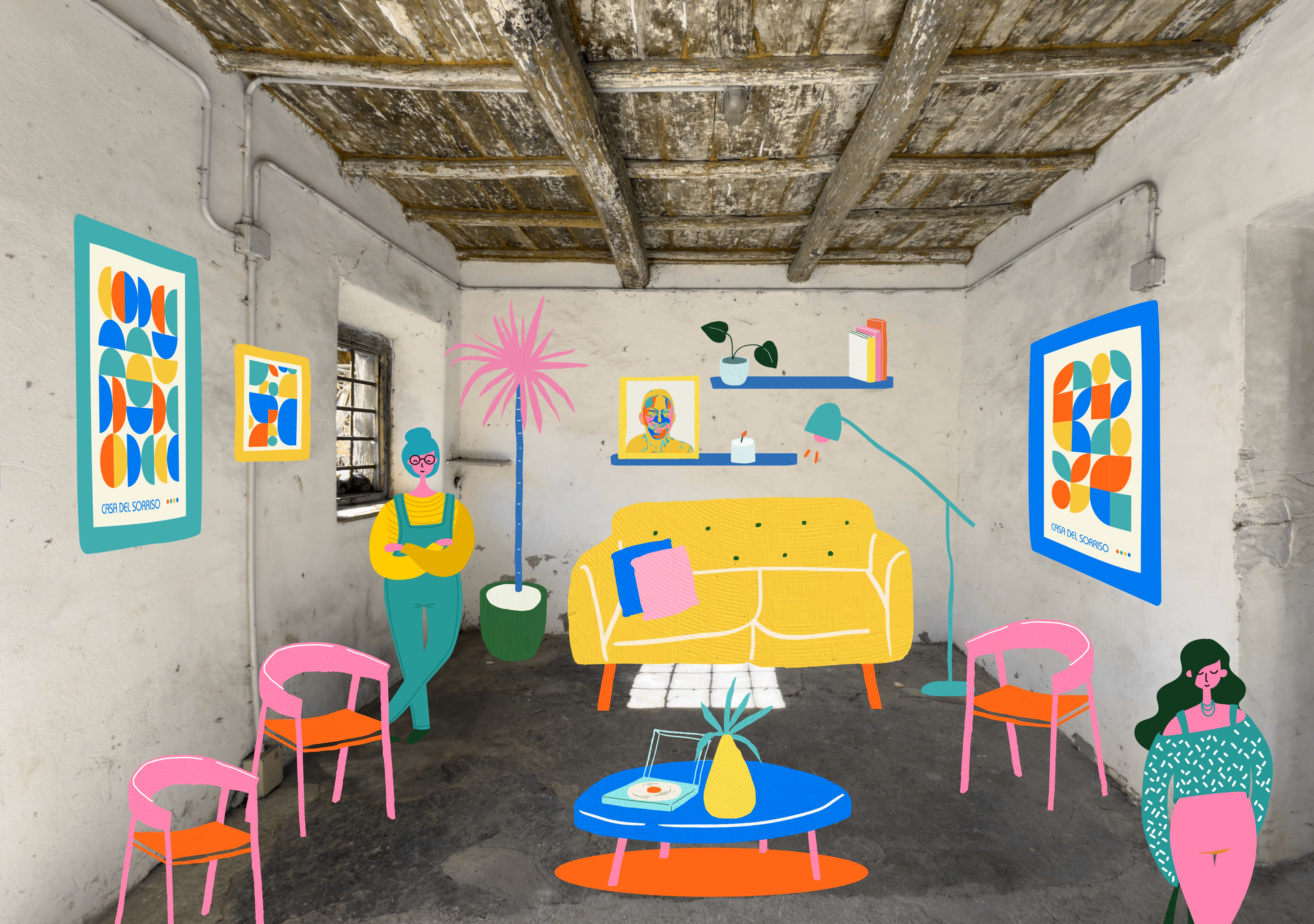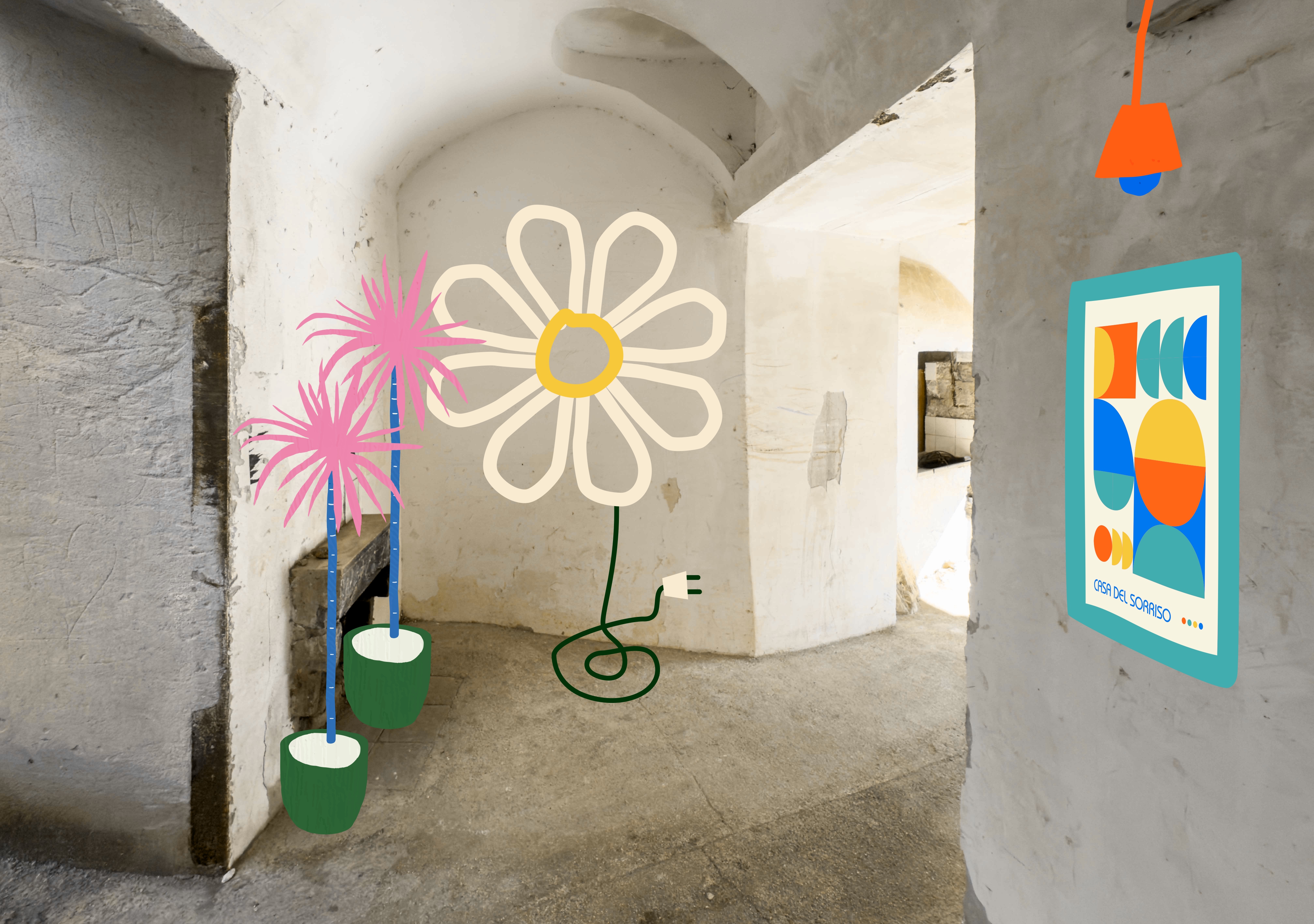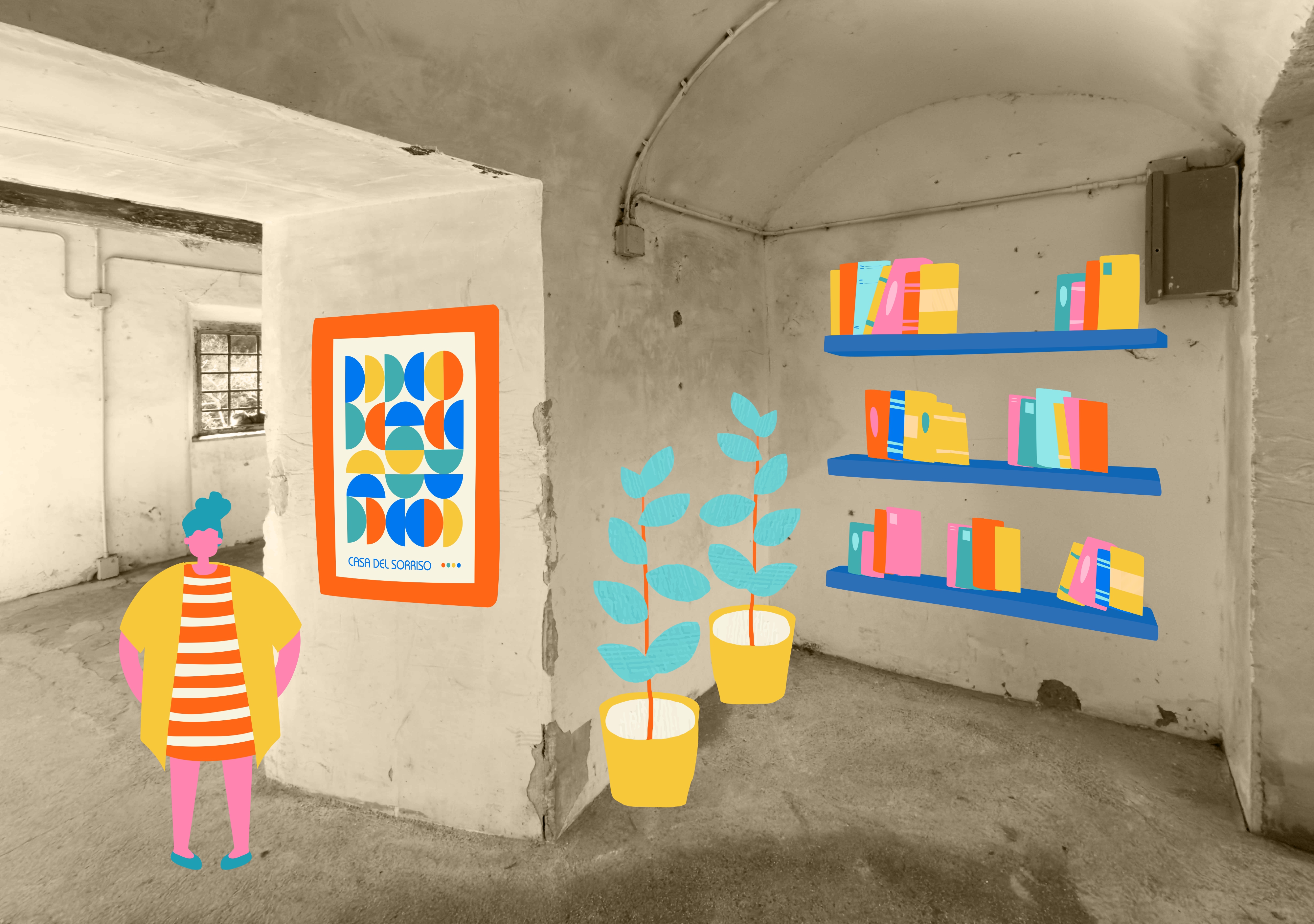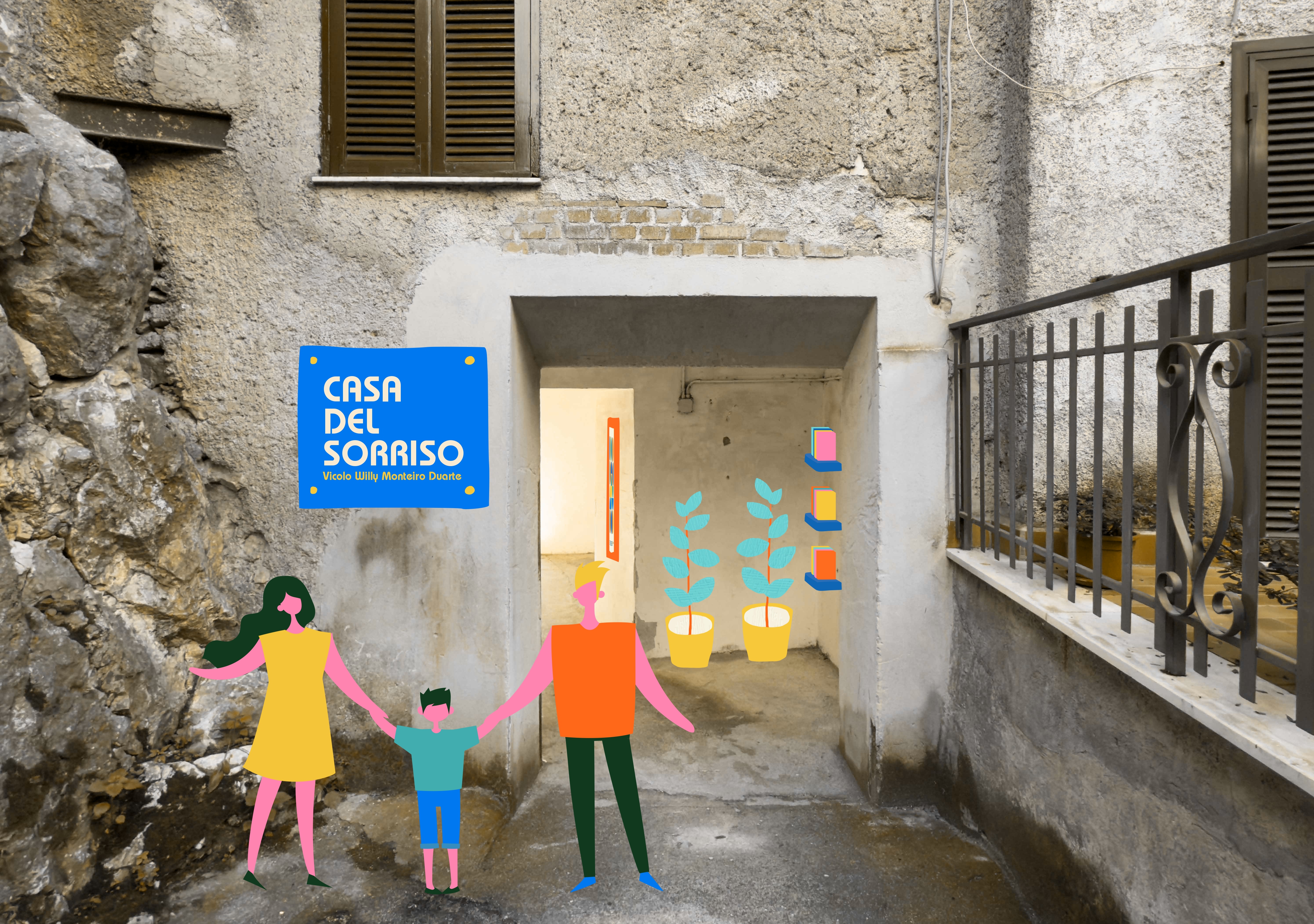House of Smiles
The Gateway dedicated to Willy Monteiro Duarte
"House of Smiles" is more than a home: it's a gateway. An abandoned space in Artena is reborn as an open path, transforming into a vibrant entrance to the city, where inclusion and community take center stage. Dedicated to Willy Monteiro Duarte, it symbolizes openness, memory, and resilience. Through art, storytelling, and participation, it welcomes all, inviting everyone to be part of a new, shared urban space where the city opens up and smiles again.
Italy
{Empty}
Early initiative
Yes
Yes
Yes
No
No
058011: Artena (IT)
House of Smiles – A New Gateway for Artena is more than just an urban regeneration project, it’s a transformation of an abandoned house into a new entrance to Artena, where inclusion, culture, and community come together. This once-forgotten space will become an open and welcoming passage, physically connecting the historic center with the rest of the city, and symbolically embodying a place of arrival, encounter, and belonging. Dedicated to Willy Monteiro Duarte, whose memory stands for justice, kindness, and resilience, the project reimagines "Via Arco Oscuro" as a vibrant corridor of social and cultural exchange. Through art, storytelling, and participation, the community will co-create a space that celebrates openness and connection.
At its heart, House of Smiles is designed by and for the people. Local residents, artists, schools, and organizations will take part in the process, shaping the space through murals, creative installations, and shared experiences. A dedicated BookCrossing area, a "Citizens’ Living Room" for informal talks on legal awareness, and an interactive mural inspired by the power of a smile will make this place a dynamic hub for cultural engagement.
The ultimate goal is to reshape Artena’s identity, turning a once-closed and fragmented city into a more inclusive and accessible space. By September 6, 2025, on the anniversary of Willy’s passing, House of Smiles will be officially opened, a living reminder that cities must be open, welcoming, and full of life.
This is not just about regenerating a place; it’s about regenerating a sense of community, memory, and shared future.
At its heart, House of Smiles is designed by and for the people. Local residents, artists, schools, and organizations will take part in the process, shaping the space through murals, creative installations, and shared experiences. A dedicated BookCrossing area, a "Citizens’ Living Room" for informal talks on legal awareness, and an interactive mural inspired by the power of a smile will make this place a dynamic hub for cultural engagement.
The ultimate goal is to reshape Artena’s identity, turning a once-closed and fragmented city into a more inclusive and accessible space. By September 6, 2025, on the anniversary of Willy’s passing, House of Smiles will be officially opened, a living reminder that cities must be open, welcoming, and full of life.
This is not just about regenerating a place; it’s about regenerating a sense of community, memory, and shared future.
Inclusion
Urban Regeneration
Community Participation
Cultural Heritage
Social Justice
"House of Smiles" is a project deeply rooted in sustainability, aiming to transform an abandoned space into a welcoming entrance to Artena while reinforcing the town’s vision of becoming the largest pedestrianized historic center in Europe. This initiative embraces the principles of reuse, environmental responsibility, and social cohesion, ensuring that the regeneration of the space is both respectful of the past and forward-looking.
One of the key sustainability aspects of the project is the repurposing of existing structures rather than demolition and reconstruction. The house, once abandoned, will be restored using local and recycled materials, reinforcing the idea that urban renewal doesn’t require new construction but can thrive by giving new life to what already exists. This approach significantly reduces waste and resource consumption, while also maintaining the historic character of the area. Artena’s pedestrian-friendly vision aligns perfectly with House of Smiles. The project creates a new, accessible entrance that opens up the historic center, making it more inviting to residents and visitors alike, without increasing traffic or pollution. By improving walkability and designing a space that fosters community interaction, the initiative contributes to a greener, more sustainable urban model. Sustainability is also about social impact and long-term engagement. The project is designed as a shared space, where the community actively participates in its creation and management. Art installations, upcycled furniture, and urban greenery will be introduced through collaborative workshops, ensuring that every element has a story and purpose. Even the furnishings will be made with reused and eco-friendly materials, proving that sustainability is not just about preserving nature, but also about giving value to resources and craftsmanship.
Ultimately, House of Smiles is more than a restoration project, it’s a vision for a more sustainable and inclusive Artena.
One of the key sustainability aspects of the project is the repurposing of existing structures rather than demolition and reconstruction. The house, once abandoned, will be restored using local and recycled materials, reinforcing the idea that urban renewal doesn’t require new construction but can thrive by giving new life to what already exists. This approach significantly reduces waste and resource consumption, while also maintaining the historic character of the area. Artena’s pedestrian-friendly vision aligns perfectly with House of Smiles. The project creates a new, accessible entrance that opens up the historic center, making it more inviting to residents and visitors alike, without increasing traffic or pollution. By improving walkability and designing a space that fosters community interaction, the initiative contributes to a greener, more sustainable urban model. Sustainability is also about social impact and long-term engagement. The project is designed as a shared space, where the community actively participates in its creation and management. Art installations, upcycled furniture, and urban greenery will be introduced through collaborative workshops, ensuring that every element has a story and purpose. Even the furnishings will be made with reused and eco-friendly materials, proving that sustainability is not just about preserving nature, but also about giving value to resources and craftsmanship.
Ultimately, House of Smiles is more than a restoration project, it’s a vision for a more sustainable and inclusive Artena.
"House of Smiles" is more than an urban regeneration project, it is a transformation of space, identity, and experience. This abandoned house becomes a gateway, a welcoming transition between the past and the future, between closed spaces and an open city. Through design, color, and participatory art, this place will no longer be just a passage but an invitation for people to pause, reflect, and connect. Inspired by the power of a smile, the project aims to evoke positive emotions through vibrant aesthetics and engaging experiences. The once-empty walls will be filled with art and color, creating a living environment that is both warm and interactive. The entrance, featuring a striking mural of Willy Monteiro Duarte, will serve as a reminder for people that cities should be places of inclusion, kindness, and community.
Inside, the "Citizens’ Living Room" will welcome residents and visitors into a shared space for dialogue, reflection, and cultural exchange. Furnished with bright, upcycled furniture, bookshelves for a community BookCrossing initiative, and carefully placed lighting, this space will radiate a sense of warmth and hospitality. The use of repurposed materials and handcrafted decorations will emphasize sustainability while giving the house a unique and authentic character. Even the smallest details, such as playful floral designs and handcrafted art pieces, will turn corridors into places of discovery, reinforcing the idea that beauty and joy can be found in everyday spaces. As the transformation unfolds, "House of Smiles" will become a symbol of renewal, a passage where the city breathes, welcomes, and smiles again. This project will transform a pedestrian passage into a metaphor for the journey towards personal and collective well-being.
Inside, the "Citizens’ Living Room" will welcome residents and visitors into a shared space for dialogue, reflection, and cultural exchange. Furnished with bright, upcycled furniture, bookshelves for a community BookCrossing initiative, and carefully placed lighting, this space will radiate a sense of warmth and hospitality. The use of repurposed materials and handcrafted decorations will emphasize sustainability while giving the house a unique and authentic character. Even the smallest details, such as playful floral designs and handcrafted art pieces, will turn corridors into places of discovery, reinforcing the idea that beauty and joy can be found in everyday spaces. As the transformation unfolds, "House of Smiles" will become a symbol of renewal, a passage where the city breathes, welcomes, and smiles again. This project will transform a pedestrian passage into a metaphor for the journey towards personal and collective well-being.
"House of Smiles" is more than a physical transformation, it’s a statement that cities should be open, accessible, and shared by all. By converting an abandoned house into a welcoming pedestrian gateway, the project ensures that inclusion is not just a concept but a lived experience. This space becomes a metaphor for crossing into a more connected, just, and welcoming society, where every person feels a sense of belonging. One of the core principles of this initiative is universal accessibility. The space is designed to be fully pedestrian-friendly, ensuring that everyone, residents, visitors, people with disabilities, and children, can move through and engage with it freely. The design follows “Design for All” principles, using clear pathways, intuitive layouts, and seating that invites people to pause, reflect, and interact. Beyond physical access, "House of Smiles" is built on the idea that public spaces should be free and open to everyone. There are no barriers to entry—this is a community-driven, non-commercial space, where resources are shared instead of sold. A BookCrossing library allows people to exchange books, reinforcing a culture of collaboration and lifelong learning. What truly makes this space special is that it is shaped by the people who use it. From the murals to the furniture, from art installations to discussion events, every element is the result of a participatory process. Residents, artists, and community groups will be involved in co-designing and decorating the space, making it a true reflection of collective identity. A powerful symbol of inclusion, the entrance corridor is dedicated to Willy Monteiro Duarte, sending a strong message against discrimination and violence. This will be a place where people gather, discuss, and reflect, a space of shared history and future possibilities. With House of Smiles, Artena is redefining what it means to be a welcoming city, where streets don’t just connect places, but bring people together.
"House of Smiles" is a space to experience, shape, and share. From the very beginning, this initiative has been designed to put citizens at the center, ensuring that those who will benefit from it are also directly involved in its transformation. This is not just a renovation project but a community-driven process that gives people the opportunity to co-create a space that reflects their values, culture, and aspirations. The involvement starts with co-design workshops, where residents, artists, and local organizations will come together to decide how to bring the space to life. From murals and upcycled furniture to the layout of seating areas and greenery, every detail will be shaped by the people who will use the space daily. These workshops will ensure that "House of Smiles" is not just visually appealing but also functional, welcoming, and inclusive. But participation doesn’t stop at planning. Citizens will also be part of the hands-on transformation. During Community Build Days, volunteers, families, and youth groups will help paint the walls, install decorations, and bring the space to life. Civil society organizations will lead sustainability workshops, showing how materials can be repurposed into urban furniture and artistic elements.
Beyond its physical transformation, "House of Smiles" will be a hub of cultural and social engagement. Residents will be able to exchange books in the BookCrossing library, take part in discussions on legal awareness, and attend community-led events. Every month, activities will bring people together, making sure that the space remains alive and relevant.
This participatory approach will create a deeper connection between the community and the space, ensuring that people feel a sense of ownership and responsibility. More than just an urban renewal project House of Smiles represents a new way of living public spaces, where cities are open, inclusive, and shaped by those who call them home.
Beyond its physical transformation, "House of Smiles" will be a hub of cultural and social engagement. Residents will be able to exchange books in the BookCrossing library, take part in discussions on legal awareness, and attend community-led events. Every month, activities will bring people together, making sure that the space remains alive and relevant.
This participatory approach will create a deeper connection between the community and the space, ensuring that people feel a sense of ownership and responsibility. More than just an urban renewal project House of Smiles represents a new way of living public spaces, where cities are open, inclusive, and shaped by those who call them home.
The transformation of "House of Smiles" is made possible through a strong network of stakeholders, each contributing expertise, resources, and vision to ensure the project’s success. From local organizations to national associations, from political institutions to entrepreneurs, this initiative is built on collaboration, making it a model for inclusive and sustainable urban renewal. At the local level, the project is deeply rooted in the engagement of community organizations and associations that have long worked to promote social inclusion, cultural heritage, and citizen participation. These groups are actively involved in co-designing the space, leading cultural and artistic activities, and ensuring long-term community engagement. Their role is crucial in transforming "House of Smiles" into a living, evolving space shaped by the people of Artena.
At the national level, "House of Smiles" benefits from the support of EuLabTEC, a national association that is part of the New European Bauhaus Community. EuLabTEC brings expertise in sustainable and innovative urban-people regeneration, guiding the initiative to align with European principles of beauty, sustainability, and inclusion. By supporting the participatory process and exchange of best practices, EuLabTEC helps position the project as a replicable model for other historic centers in Italy and beyond. The project is also backed by political institutions and business stakeholders at the municipal and regional levels. Local government representatives facilitate the legal, administrative, and infrastructural processes, ensuring that the initiative integrates with Artena’s broader urban development plans. Entrepreneurs and regional businesses play a key role by providing materials, expertise, and potential funding, reinforcing the commitment to sustainability through the reuse of local and recycled materials.
At the national level, "House of Smiles" benefits from the support of EuLabTEC, a national association that is part of the New European Bauhaus Community. EuLabTEC brings expertise in sustainable and innovative urban-people regeneration, guiding the initiative to align with European principles of beauty, sustainability, and inclusion. By supporting the participatory process and exchange of best practices, EuLabTEC helps position the project as a replicable model for other historic centers in Italy and beyond. The project is also backed by political institutions and business stakeholders at the municipal and regional levels. Local government representatives facilitate the legal, administrative, and infrastructural processes, ensuring that the initiative integrates with Artena’s broader urban development plans. Entrepreneurs and regional businesses play a key role by providing materials, expertise, and potential funding, reinforcing the commitment to sustainability through the reuse of local and recycled materials.
The House of Smiles project is shaping a space that is not only functional but also socially meaningful, environmentally responsible, and culturally vibrant by bringing together different disciplines and expertise. Through a collaboration of urban planning, sustainability, social sciences, arts, and policy-making, the initiative is creating a place where people are designing their own environment. At its core, House of Smiles is transforming an abandoned passage into a welcoming and inclusive gateway, aligning with Artena’s vision of becoming Europe’s largest pedestrianized historic center. Urban planners and architects are preserving the historical essence of the space while ensuring it is becoming more accessible, functional, and inviting. The project is focusing on walkability, adaptive reuse of materials, and the integration of sustainable elements, so the passage is evolving from a forgotten shortcut into a symbol of openness and renewal. Sustainability experts are guiding the use of recycled and locally sourced materials, while urban designers are incorporating green elements and energy-efficient solutions, demonstrating how historic centers are embracing modern ecological principles without losing their identity. Social scientists and community organizers are engaging with local residents to ensure that the space is reflecting their needs and aspirations. Public consultations are involving citizens in co-creating a space that fosters interaction and inclusion. The Gateway dedicated to Willy Monteiro Duarte is reinforcing the project’s commitment to social justice, turning House of Smiles into a beacon of diversity and respect. At the same time, artists and cultural organizations are leading the creative transformation by painting murals, installing interactive art, and curating exhibitions that are turning the space into a living canvas of collective identity. House of Smiles is redefining how people are experiencing the city.
The innovation behind House of Smiles is not only in the participatory approach but in the transformation of the space itself. Instead of demolishing an old structure to create a new entrance, the project is reimagining an existing house, turning its former interior passageways into a new pedestrian gateway to the city. What was once a private home is becoming a public space, blurring the line between inside and outside, private and collective, past and future. This approach challenges conventional urban renewal methods, which often rely on demolition and new construction. Here, the innovation lies in adapting what already exists, using the original walls, corridors, and rooms to shape an inclusive and symbolic entrance to Artena. The Gateway dedicated to Willy Monteiro Duarte is not just a functional passage but a space of meaning, a place that welcomes people while reminding them of the city’s values of openness and community. Sustainability is not just a concept, it is embedded in the very structure of the project. Rather than wasting materials or altering the city’s historic fabric, House of Smiles is embracing adaptive reuse, proving that cities can evolve without erasing their past. The project is integrating recycled materials, artistic interventions, and community-led design to ensure that the space remains both aesthetically rich and environmentally responsible. Unlike traditional regeneration projects that restore existing spaces for the same functions, House of Smiles is reprogramming a private dwelling into a shared urban experience. The house’s former rooms are turning into spaces for reading, dialogue, and art, with a BookCrossing library, a Citizens’ Living Room, and interactive murals shaping a new kind of public place, a home for the community. With the support of EuLabTEC, this project is demonstrating that true urban innovation comes not from erasing history, but from transforming it into something new.
At the heart of the project is a deeply participatory approach, ensuring that the people of Artena are not just spectators but active contributors to the process. To guide this transformation, the initiative is following the principles of the New European Bauhaus (NEB) Compass and Toolkit, using them as operational frameworks to create a space that is sustainable, inclusive, and meaningful.
Rather than demolishing and rebuilding, House of Smiles is embracing adaptive reuse, turning the former interior access points of a house into a new pedestrian gateway. This approach preserves the identity of the historic center while allowing the space to be reimagined for contemporary needs. Following NEB principles, the design is balancing heritage with innovation, proving that urban regeneration does not have to mean erasing the past. The participatory methodology is ensuring that the community leads the transformation. Through co-design workshops, artistic interventions, and collaborative decision-making, local residents, artists, and civic organizations are shaping the space together. The NEB Toolkit is guiding this process, helping to structure engagement in a way that is inclusive, creative, and action-oriented. Sustainability is at the core of both the methodology and the execution. The project is prioritizing material reuse, incorporating recycled and locally sourced elements into the renovation. This aligns with NEB’s focus on the circular economy, showing how sustainability can be practical, beautiful, and socially engaging. By merging community participation, sustainability, and adaptive reuse, House of Smiles is not only transforming a spac, it is reshaping how cities evolve with their people, offering a replicable model of participatory urban renewal in historic centers across Europe.
Rather than demolishing and rebuilding, House of Smiles is embracing adaptive reuse, turning the former interior access points of a house into a new pedestrian gateway. This approach preserves the identity of the historic center while allowing the space to be reimagined for contemporary needs. Following NEB principles, the design is balancing heritage with innovation, proving that urban regeneration does not have to mean erasing the past. The participatory methodology is ensuring that the community leads the transformation. Through co-design workshops, artistic interventions, and collaborative decision-making, local residents, artists, and civic organizations are shaping the space together. The NEB Toolkit is guiding this process, helping to structure engagement in a way that is inclusive, creative, and action-oriented. Sustainability is at the core of both the methodology and the execution. The project is prioritizing material reuse, incorporating recycled and locally sourced elements into the renovation. This aligns with NEB’s focus on the circular economy, showing how sustainability can be practical, beautiful, and socially engaging. By merging community participation, sustainability, and adaptive reuse, House of Smiles is not only transforming a spac, it is reshaping how cities evolve with their people, offering a replicable model of participatory urban renewal in historic centers across Europe.
The House of Smiles project is not just a unique intervention in Artena, it is a model that can be adapted and replicated in other historic centers, pedestrian areas, and community-led initiatives. Its strength lies in its methodology, which prioritizes participation, sustainability, and cultural identity, making it a flexible and scalable approach to urban transformation. One of the most transferable aspects of the project is its participatory urbanism. Instead of a top-down approach, House of Smiles is engaging residents, artists, and local organizations in the co-creation of the space. Guided by the New European Bauhaus (NEB) Compass and Toolkit, the process ensures that the community is actively shaping the project, rather than simply receiving it. This methodology can be applied to any city looking to involve its citizens in meaningful urban renewal. Another key innovation is the adaptive reuse of an existing house to create a new pedestrian entrance. Instead of demolishing and rebuilding, the project is transforming old passageways into a welcoming city gateway, proving that urban spaces can be reimagined rather than erased. Many historic centers across Europe face similar challenges, and this approach can be replicated to preserve architectural heritage while modernizing spaces for public use. The project is using recycled and locally sourced materials, reducing waste and demonstrating that sustainability can be practical, cost-effective, and community-driven. This approach can inspire other cities to integrate sustainability into urban design, making regeneration projects more environmentally conscious.
Finally, House of Smiles is turning a passageway into a cultural and social hub. With a BookCrossing library, a Citizens’ Living Room, and interactive public art, the space is becoming a meeting point for dialogue, learning, and creativity. This concept can be applied to any underused urban and no-urban space.
Finally, House of Smiles is turning a passageway into a cultural and social hub. With a BookCrossing library, a Citizens’ Living Room, and interactive public art, the space is becoming a meeting point for dialogue, learning, and creativity. This concept can be applied to any underused urban and no-urban space.
The "House of Smiles" project is much more than an urban regeneration initiative, it is a response to major global challenges through sustainability, inclusion, and participatory urbanism. By transforming an abandoned home into a new entrance to the city, the project is proving that small, community-led actions can address larger issues such as climate change, social isolation, and the loss of public spaces. One of the most pressing global challenges is sustainable urban development. Many regeneration projects rely on demolition and new construction, leading to waste and loss of cultural heritage. "House of Smiles" takes a different approach, preserving an existing structure and adapting it to new uses, proving that urban growth does not have to come at the expense of history and sustainability.
At the same time, cities around the world are struggling with the loss of inclusive public spaces. Many urban areas are becoming privatized or inaccessible, weakening social connections. "House of Smiles" is reversing this trend, turning an old home into a shared cultural and social space where people can gather, interact, and take part in community life. This project demonstrates that even small interventions can rebuild a sense of belonging and make cities more welcoming and people-centered. Accessibility and walkability are also major global urban challenges, especially in historic centers. As Artena works towards becoming Europe’s largest pedestrianized historic district, "House of Smiles" is ensuring that this transformation is inclusive, creating a new entrance that is open and accessible to all. Beyond the physical transformation, the project is setting an example for participatory urbanism. This approach strengthens local identity and proves that cities should be built with and for the people. House of Smiles is showing that local solutions can drive global change. It is a scalable model that can be replicated in historic centers and urban areas across Europe.
At the same time, cities around the world are struggling with the loss of inclusive public spaces. Many urban areas are becoming privatized or inaccessible, weakening social connections. "House of Smiles" is reversing this trend, turning an old home into a shared cultural and social space where people can gather, interact, and take part in community life. This project demonstrates that even small interventions can rebuild a sense of belonging and make cities more welcoming and people-centered. Accessibility and walkability are also major global urban challenges, especially in historic centers. As Artena works towards becoming Europe’s largest pedestrianized historic district, "House of Smiles" is ensuring that this transformation is inclusive, creating a new entrance that is open and accessible to all. Beyond the physical transformation, the project is setting an example for participatory urbanism. This approach strengthens local identity and proves that cities should be built with and for the people. House of Smiles is showing that local solutions can drive global change. It is a scalable model that can be replicated in historic centers and urban areas across Europe.
The House of Smiles project is moving forward with a clear roadmap, ensuring that every phase respects the values of sustainability, inclusion, and beauty outlined by the New European Bauhaus (NEB). This initiative is not just about restoring a space, it is about redefining it through participation, culture, and sustainable design.
The first step is actively involving the community. Through storytelling sessions and exploratory walks, residents are mapping the history and needs of the space, turning their experiences into a collective vision for the transformation. This process ensures that the space is not imposed but co-created, aligning with the NEB’s principle of designing with and for the people. Next, the project is moving into co-design workshops, where urban planners, local artisans, and citizens are shaping the aesthetic and functional elements of the space. Sustainability is at the core of this phase, with a strong focus on using recycled materials for furniture, urban greenery, and artistic installations. Instead of demolishing and building anew, the project is proving that urban spaces can be reimagined through adaptive reuse, maintaining the city’s identity while making it more livable. In the following months, the transformation will take a hands-on approach, inviting residents to participate in community build days, mural painting, and public art creation. The space will officially reopen with a festival, celebrating its new life as a pedestrian gateway and cultural hub.
The project is already being integrated into Artena’s 2025-2027 urban development plan, ensuring its long-term sustainability. Additionally, institutional support is in place, with the Municipality committed to securing funds and maintaining the space. Through this process, House of Smiles is demonstrating how urban regeneration can be people-driven, environmentally responsible, and culturally meaningful, making it a replicable model for other historic centers across Europe.
The first step is actively involving the community. Through storytelling sessions and exploratory walks, residents are mapping the history and needs of the space, turning their experiences into a collective vision for the transformation. This process ensures that the space is not imposed but co-created, aligning with the NEB’s principle of designing with and for the people. Next, the project is moving into co-design workshops, where urban planners, local artisans, and citizens are shaping the aesthetic and functional elements of the space. Sustainability is at the core of this phase, with a strong focus on using recycled materials for furniture, urban greenery, and artistic installations. Instead of demolishing and building anew, the project is proving that urban spaces can be reimagined through adaptive reuse, maintaining the city’s identity while making it more livable. In the following months, the transformation will take a hands-on approach, inviting residents to participate in community build days, mural painting, and public art creation. The space will officially reopen with a festival, celebrating its new life as a pedestrian gateway and cultural hub.
The project is already being integrated into Artena’s 2025-2027 urban development plan, ensuring its long-term sustainability. Additionally, institutional support is in place, with the Municipality committed to securing funds and maintaining the space. Through this process, House of Smiles is demonstrating how urban regeneration can be people-driven, environmentally responsible, and culturally meaningful, making it a replicable model for other historic centers across Europe.

